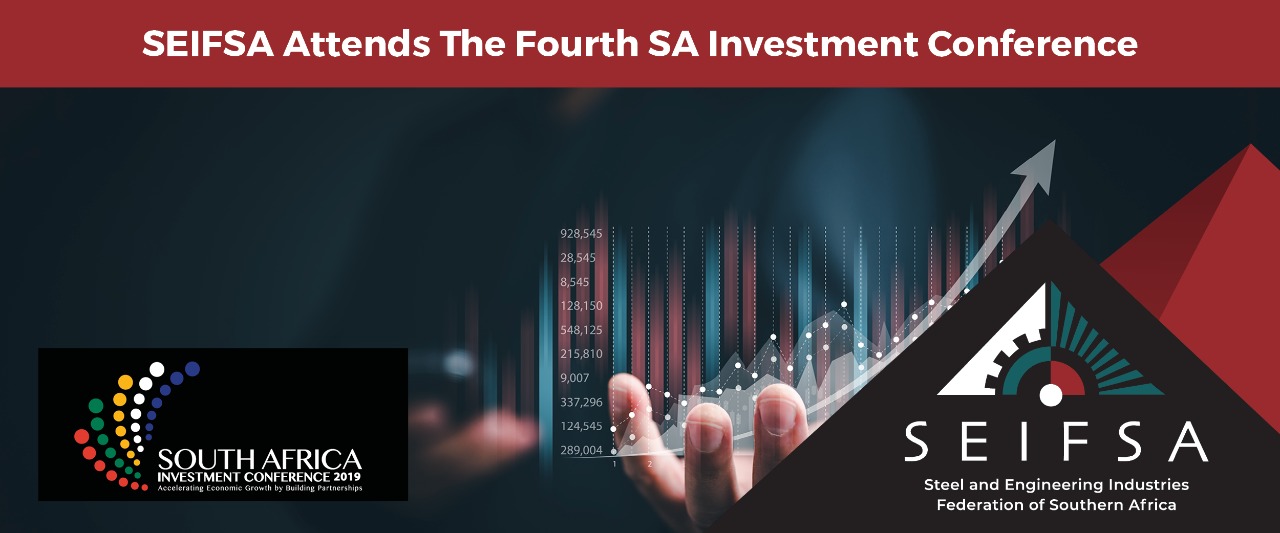SEIFSA attends the fourth SA Investment Conference
In 2018 President Cyril Ramaphosa set an ambitious target to attract R1.2 trillion in foreign and domestic investment over a five-year period. This year, R332 billion worth of investment pledges were made, bringing the total investment pledges in four years to R1.14 trillion. This amount strips out project cancellations and deferred projects. Investments announced specific to the metals and metal fabrication sector alone amounted to R18.9 billion.
This leaves an amount of R60 billion needed to meet the target set by the President. Ramaphosa in closing the conference indicated that not only was he confident that this shortfall would be met, but in all likelihood, it would be exceeded.
SEIFSA was represented at the conference by the President of the Federation, Elias Monage, Chief Executive Officer, Lucio Trentini, and Chief Operating Officer, Tafadzwa Chibanguza. SEIFSA’s attendance at the conference was important as the event brings together almost all of the country’s senior role players in the economy under one roof. This platform provided an important opportunity for SEIFSA officials to meet with and lay the groundwork for two important events that are being planned by the Federation, namely: the meeting between SEIFSA and the Group Chief Executive Officer at Eskom which will be held in April 2022 and the Steel Master Plan Conference scheduled to take place in May 2022.
It also allowed an opportunity to meet and exchange details with a number of Presidential and Ministerial advisers, representatives of other organised business formations and government officials that share or serve the strategic interests of SEIFSA and in turn the affiliated membership.
An interesting theme that came to dominate the conversation at the conference was a comment made by Discovery, CEO, Mr. Adrian Gore. While on a panel he highlighted that in many aspects, there is often a divergent understanding between narrative versus reality. South Africa, he indicated is not sparred this fact, where reality is sometimes not as bad as the negative narrative that is continuously peddled. Gore went on to explain that the narrative is often that South Africa suffers from a poor and disappointingly low growth rate (averaging 1% to 1.5%) over the last decade. The reality, he pointed out, is that growth is stable, particularly when compared to other emerging economies with wild fluctuations in their GDP outcomes. Similarly, the fact that a number of sectors have rebounded to pre-covid levels, indicates some resilience in the economy. That is not to say that all is well with the South African economy, however, the point is that the negative narrative often carries the most attention and by extension adversely influences sentiment. The reverse he emphasised should then also hold, namely, that a lot more should be done by leaders to emphasise the reliance of the SA economy, its people, and businesses. This was a message that taken together with the point that perceptions shape our reality and the power of positive narrative stuck for the rest of the conference.
Some of the key points highlighted by companies that announced investments include:
South Africa has a relatively well developed soft and hard infrastructure base, particularly when compared to other African country economies;
- A lot of the industrial productive capacity competes well globally;
- A diverse and good skills pool;
- A resilient economy; and
- SA remains a springboard onto the continent.
The need to open avenues for greater private sector investment in the provision of infrastructure was highlighted by business leaders across the board. Businesses made the point, amongst others, that infrastructure bottlenecks in electricity, rail, and water are choking the potential of the economy. Reform in these areas will not only attract investment into the country to resolve the infrastructure challenges, but better infrastructure will help to sell and position the country as a preferred investment destination. This is a point of reform that SEIFSA on behalf of its Associations and affiliated membership will continue to lobby and advocate.
Health regulations to deal with Covid-19 and other medical conditions outside of the National State of Disaster
Dear Members
The Department of Health has published the proposed health regulations to deal with Covid-19 and other medical conditions outside of the National State of Disaster for public comment.
This effort is part of Government’s transition plans from the current National State of Disaster which has been in place for more than 2 years. These regulations have been presented to the NATJOINTS structures including the Legal and Regulatory Measures Workstream. Once approved, these regulations will be implemented within the National Department of Health with the support of some of the public entities reporting to the department and will not be tabled before Parliament as they are subordinate legislation.
The proposed regulations seek to introduce a number of control measures which include the:
• Surveillance and Control of Notifiable Medical Conditions;
• Public Health measures in points of entry;
• Management of Human Remains;
• Regulations relating to Environmental Health;
The regulations propose the following:
• Measures in ports of entry: all people entering or exiting South Africa during the pandemic, should present negative PCR test results not older than 72 hours, in the event that they do not- have a full vaccination certificate. This repeals the current requirement of negative PCR test results for all incoming travellers- with or without a vaccination certificate.
• As part of efforts to manage transmission during large gatherings considered to be possible super spreader events, the regulations proposed the restriction of night vigils and after-funeral gatherings. The indoor and outdoor gatherings may be occupied up to 50% of the venue capacity provided there is production of a valid vaccine certificate; practice of social distance of at least one metre and compulsory wearing of masks. The attendance of outdoor gatherings without proof of vaccination will be limited to only 1000 people and 2000 for outdoors with social distancing of at least one metre social distance.
SEIFSA being part of BUSA will contribute to the broader business response to these regulations.
Click here for the regulations for your perusal
Draft-Health-Regulations-published-for-public-comments-46045-15-March-2022
Metals sector urged to seize South Africa’s beckoning Steel Master Plan opportunity
JOHANNESBURG (miningweekly.com) – South Africa’s historic metals sector employer organisation on Wednesday urged all the sector’s employer bodies to roll up their sleeves on May 19 and 20 and get their teeth into the Steel Master Plan, which is seen to have promising reindustrialisation elements.
President Cyril Ramaphosa highlighted the Steel Master Plan in last month’s State of the Nation Address.
An upbeat Lucio Trentini, in his capacity as the CEO of the nigh-80-year-old Steel and Engineering Industries Federation of Southern Africa (Seifsa), described the challenges faced by the metals and engineering sector as being “quite daunting” and highlighted the amazing resilience that members had displayed in the last 12 to 18 months. (Also watch attached Creamer Media video.)
Seifsa has a combined membership of more than 1 200 companies that employ more than 170 000 personnel. Formed in 1943, its members range from giant steelmaking corporations to microenterprises employing fewer than 50 people.
“The message that I want to put out is that this industry stands ready to make its contribution to translating government’s vision of reindustrialising the metals and engineering sector, and to start translating visions, promises and policy into action and deliverables
“What we need is for the government to roll out its promised infrastructure spend, which is absolutely central to the reigniting of industrial capacity in the sector. I can assure you, if we see half of what government has promised, the sector will ignite, move forward and create the much-needed economic growth and consequent jobs and job opportunities that this country so sorely needs. We’re ready, we want to do our bit,” said Trentini in a Zoom interview with Engineering News & Mining Weekly.
The knock-on effects are felt throughout the economy owing to the sector’s role as supplier and customer into the mining, automotive, motor, construction and other manufacturing sub-industries.
“Because of the nature of our economy and its size, the major sectors of our economy are all interrelated, so when one cog in the wheel experiences a stutter, the effects are felt throughout the value chain,” said Trentini.
During the three-week stoppage of the sector last year, more than R300-million a week in lost wages and more than R600-million a week in lost revenue was shed by the sector – and those are very conservative figures.
“The knock-on effect into mining, construction, automotive component manufacturers, automotive assemblers was felt very deeply,” said the head of the organisation that sets out to foster mutually-beneficial relationships between employers, labour and government in creating a business environment conducive to growth.
When Trentini joined South Africa’s metals and engineering sector from JCI Gold and Uranium Company 30-odd years ago, it employed more than half-a-million blue-collar workers. Sadly, it is now down to half that number.
“Jobs are scarce and we need to hold on to the jobs we have and allow the government to create an enabling environment,” said action-orientated Trentini.
He sees the Steel Master Plan, already signed by representatives of business, labour and government, as being an integral part of the new enabling environment that the government is heralding, and urges all relevant organisations to put their shoulder to the plan’s wheel at its upcoming conference on May 19 and 20.
“It’s not going to create any miracles overnight but it’s the first time that government, through Trade, Industry and Competition Minister Ebrahim Patel, has come to business to ask what it can do together with labour, to address the challenges that we face as a sector,” he said.
Localisation and designation without having to compromise on cost and quality is the plan’s focus.
“We now know that there are going to be massive increases in the price of steel because of what is happening in the Russian-Ukrainian conflict and the price of steel, which is a major input into all of this industry, is a major issue up for discussion,” said Trentini.
Sought will be a way of bridging the gap between the upstream primary steel producers and the downstream fabricators.
“We have to sit down, we have to talk, we have to be honest, and we have to confront the so-called brutal truths if we are going to make progress. If we don't do that, the Steel Master Plan will be another vision that doesn’t see the light of day – and I don’t think we have much time.
“There’s a lot happening in our country and the sooner we start sitting down and rolling up our sleeves and getting our teeth into the various issues that the Steel Master Plan wants to focus on, the better,” Trentini added.
Seifsa will be using the period ahead of the next round of wage negotiations in 2024 to get stuck into what it highlights as ten critical objectives.
In addition to the Steel Master Plan, these include skills development and human capital, transformation, revival and inclusiveness, electricity and energy, import-export and international trade, and talking to the economic cluster about what they see unfolding in the next year to three years.
“I was bitterly disappointed that, at the signing of the Steel Master Plan, Seifsa was the only employer organisation present. Yes, Seifsa is the largest and the most influential, but it’s not the sector's only employer organisation, and I think it’s critically important that all employer organisations play a role because all employer organisations represent their respective constituencies and those remaining outside are doing their constituencies a disservice. We don't have another metals and engineering industry. This is the only one we have. It’s best that everyone comes in to attend and best if everyone brings their sharp minds and their intellect and their creative ideas to try to move this industry forward as quickly as possible, because, I stress, we don’t have a lot of time,” said Trentini.
As Engineering News has reported, the launch of the Steel Master Plan took place amid the constant hum of heavy machinery at Hall Longmore’s factory in Wadeville, Gauteng.
The 80-page document has been published following nearly two years of “robust” talks, facilitated by Dr Bernie Fanaroff, the former trade unionist and leading post-Apartheid government administrator, who also played a prominent role in South Africa’s successful bid to co-host the Square Kilometre Array project.
It has been signed against the backdrop of serious Covid-linked steel supply backlogs.
During the ceremony, Barnes Group director Doron Barnes, whose company acquired steel pipe manufacturer Hall Longmore from Murray & Roberts in 2014, was quoted as saying that he had already witnessed first-hand the power of collaboration, with government’s intervention having played a key role in averting the closure of Hall Longmore and having its equipment relocated to Nigeria.
“It is always easier to complain, blame and criticise rather than to put in a meaningful effort to create sustainable solutions,” Barnes said in his address on the factory floor, adding that the master plan created the platform to “map a way forward” with the support of government.
It was stated that the plan had been developed on three pillars, namely:
boosting demand for steel and steel products, primarily by reviving South Africa’s stalled public infrastructure roll-out; driving localisation, or import substitution; and by leveraging the market access being created through the implementation of the African Continental Free Trade Agreement;
addressing supply-side constraints, including electricity disruptions and tariff hikes, logistics bottlenecks, uncompetitive inputs and inadequate skills, and research and development; and
a series of cross-cutting interventions, including the creation of a Steel Industry Development Fund, to be capitalised through the introduction of a levy of between R5/t and R10/t on all steel sold domestically, whether it be produced locally or imported.
“It’s going to be about increasing domestic demand for steel,” Patel explained at the signing.
“The big gains will be made by moving our infrastructure programme from shallow waters to deep waters and to get it moving on a bigger scale and then introducing a localisation requirement not only on primary steel, but also downstream steel.”
Patel reiterated his contention that there was scope for higher levels of localisation, including localisation of steel and metal products and that an accord had been reached at the National Economic Development and Labour Council to drive progressive localisation of up to R200-billion of additional production over a five-year period.
National Union of Metalworkers of South Africa general secretary Irvin Jim, who put his signature to the master plan, argued that the steel industry needed to begin casting its mind beyond being in “survival mode” and use the platform to reverse deindustrialisation and put a stop to the jobs “bloodbath”.
Metals and engineering sector production expands but downside risks remain
Johannesburg, 10 March 2022: Production in the metals and engineering sector started the year on a relatively strong note. On a year-on-year basis, production in the total sector expanded by 1.2% in January 2022. On a month-on-month basis between December 2021 and January 2022, production in the sector expanded 4.7%. Total sales increased by 6.2% between these two months from R67.4 billion to R71.6 billion, notes SEIFSA’s Chief Operating Officer, Tafadzwa Chibanguza.
Increases were noted in the electrical machinery products (14%), rubber products (12%) and basic iron and steel (11%). On the contrary, production decreases experienced in in the vehicle parts and accessories (-12%), household appliances (-9%), and structural metal products (-6%).
This is also on the back of the 2.9% year-on-year production growth recorded for the total manufacturing sector in January 2022. Between December 2021 and January 2022, total manufacturing production expanded by 1.9%. The metals and engineering sector, made up of 13 sub-sectors, constitutes 30.9% of the total manufacturing sector. It is encouraging to note that at an aggregate level, production levels in the metals and engineering sector reached pre-covid-19 levels by December 2021.
Chibanguza said “The positive production data recorded in January 2022 is very much in line with the other data points released in the last few days, namely the Purchasing Managers Index and the Business Confidence Index, which all showed notable improvement. This confirms the fact that from the last quarter of 2021 into the first few months of 2022, global economic recovery was starting to take shape and generally supportive of domestic growth in various sectors. However, the geo-political developments involving Russia and Ukraine present downside risks for this recovery”
Risks include heightened uncertainty, volatility and inflationary risks that will manifest through food and the commodities complex including oil prices. This will likely to force the South African Reserve Bank to act much sooner and more aggressively than originally anticipated hurting the prospects of the recovery. Domestically, the recent bouts of load shedding will also dampen the outlook of the productive sectors.
While South Africa cannot do too much about the global geo-political landscape and the risks that will manifest from the developments in that arena, resolving domestic challenges, through implementing urgent reform in the electricity supply industry is entirely in the country’s control. Hence, SEIFSA will continue to press for the necessary reforms to safeguard productive capacity in order to stimulate much-needed growth, Chibanguza concluded.




